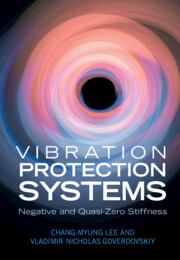Book contents
- Vibration Protection Systems
- Vibration Protection Systems
- Copyright page
- Contents
- Preface
- Acknowledgments
- Glossary
- 1 Vibrations Destroying Human–Machine Systems Inside and Outside
- 2 Vibration Protection Systems with Negative and Quasi-Zero Stiffness
- 3 Modeling of Elastic Postbuckling in Large and Dimensioning the Mechanisms with Negative Stiffness
- 4 The Type and Number Synthesis of Function-Generating Mechanisms
- 5 Dynamics of Systems with Sign-Changing Stiffness
- 6 Dynamics of Systems with Sign-Changing Stiffness
- 7 Dynamics of Systems with Sign-Changing Stiffness
- 8 Methods of Experimental Study of Vibration Protection Systems with Negative and Quasi-Zero Stiffness
- 9 In Harmony with Conventional Vibration Protection Systems
- 10 Development and Use of Vibration Protection Systems with Negative and Quasi-Zero Stiffness
- Index
- References
10 - Development and Use of Vibration Protection Systems with Negative and Quasi-Zero Stiffness
Practice and Prospects
Published online by Cambridge University Press: 29 October 2021
- Vibration Protection Systems
- Vibration Protection Systems
- Copyright page
- Contents
- Preface
- Acknowledgments
- Glossary
- 1 Vibrations Destroying Human–Machine Systems Inside and Outside
- 2 Vibration Protection Systems with Negative and Quasi-Zero Stiffness
- 3 Modeling of Elastic Postbuckling in Large and Dimensioning the Mechanisms with Negative Stiffness
- 4 The Type and Number Synthesis of Function-Generating Mechanisms
- 5 Dynamics of Systems with Sign-Changing Stiffness
- 6 Dynamics of Systems with Sign-Changing Stiffness
- 7 Dynamics of Systems with Sign-Changing Stiffness
- 8 Methods of Experimental Study of Vibration Protection Systems with Negative and Quasi-Zero Stiffness
- 9 In Harmony with Conventional Vibration Protection Systems
- 10 Development and Use of Vibration Protection Systems with Negative and Quasi-Zero Stiffness
- Index
- References
Summary
Results of study in the field and practical use of vibration protection systems with compact mechanisms (removable modules) of negative stiffness are presented, obtained over the years. These are authoring systems considered as an alternative to conventional systems to protect humans against the most dangerous and harmful vibrations. This was proved in the land transport vehicles (electric buses, heavy trucks), construction equipment (wheel cranes and loaders, caterpillar excavators), harvester combines, and in mid-size and heavy helicopters. In some cases, efficiency of vibration protection was increased 100 to 700 times in the infra- and 1500 times in the low-frequency ranges. Using the theory of similarity and dimensions, one can design a lineup of compact systems with payload capacity of 150 to 250,000 N, however, closely approximated in dimensions, for other objects of vibration protection. In active control, operation frequency range of the systems can start from 0.05 to 0.1 Hz. With the advent of fundamentally new structural and functional materials, the possibilities of systems with negative and quasi-zero stiffness seem unlimited. For instance, substituting the parametric elements from spring steels with composites of carbon fibers increases 4−5 times the travel, and we hope to increase longtime durability under nonlinear postbuckling.
Keywords
- Type
- Chapter
- Information
- Vibration Protection SystemsNegative and Quasi-Zero Stiffness, pp. 264 - 293Publisher: Cambridge University PressPrint publication year: 2021

